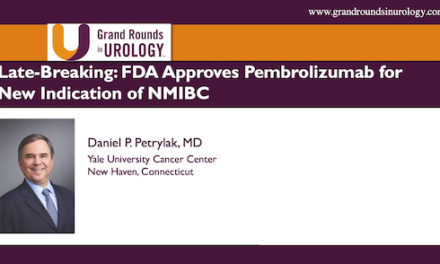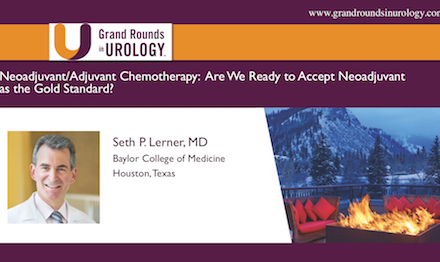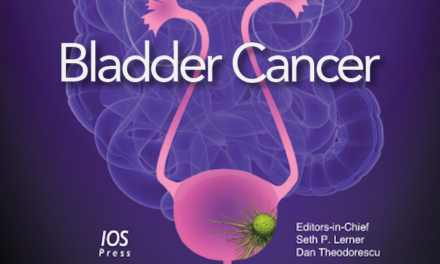Dr. Jehonathan Pinthus presented “Thromboembolic Complications in Bladder Cancer” at the International Bladder Cancer Update meeting on Tuesday, January 24, 2017.
Keywords: bladder cancer, chemotherapy, cystectomy, neoadjuvant, prophylaxis, thromboembolic, VTE
How to cite: Pinthus, Jehonathan. “Thromboembolic Complications in Bladder Cancer” January 24, 2017. Accessed Jan 2025. https://dev.grandroundsinurology.com/thromboembolic-complications-bladder-cancer
Thromboembolic Complications in Bladder Cancer
I would like to take you through three trajectories of the disease, one is in the post or peri-radical cystectomy, and time. The other one it’s a different patient population, which I think deserves specific attentions, and those are the patients who receive neoadjuvant cisplatin-based chemotherapy. And finally, a few words about metastatic bladder cancer.
There is an accumulating data to suggest that cancer confirms an increased risk for development of thromboembolic disease. However, the risks vary with different types of cancer. This is data from 11 different tumor sites or tumor tissues that were treated surgically. This is the NSQIP, the National Surgical Quality Improvement Program of the American College of Surgeons, and this looks at the 30-day incidence of DVT in patients that were operated for these types of cancers. And you can see that bladder cancer confirms a significant risk of DVT, only second to esophagectomy. When you actually look at PE bladder cancer surpasses esophagectomy as the number one cause of, or number one in terms of development of PE, and if you look at all VTE or venous thromboembolic events, it’s again very high and second only to esophageal cancer.
What do we know about the radical cystectomy? So, there is company from Oregon, looked at the same method, and looked at 1,300 patients that underwent radical cystectomy, and there are very few interesting observations in this retrospective observation trial. So, first of all there were 6% overall incidence of clinical venous thromboembolic events, and the median time for that was 14 days. So, the risk of actually developing VTE exceeds beyond discharge from hospital after radical cystectomy. In fact, half of the patients were diagnosed with VTE after discharge. And the 30-day mortality related to VTE is enormous, it’s about 6%. Within the limitations of her study she could look at, she could predict that age and operative time and sepsis were associated with a VTE. So, more than 50% of the patients developed VTE post-discharge from radical cystectomy. There may be a role for extended VTE prophylaxis. This is just another graphic presentation of what she showed.
And indeed, there was the Sanofi trial, the ENOXACAN II trial that looked at extended versus non-extended prophylaxis with low molecular weight heparin. This was not a urological-specific study. About 10% of the procedures there were urological, but it was a double-blind randomized multicenter trial in patients undergoing planned curative open surgery for abdomen or pelvic cancer. They received either an enoxaparin for up to ten days to discharge and then randomized to either receive placebo or 21 days of an enoxaparin. The endpoint here is a little bit disappointing, but that was early days. It’s radiologically detected VTE or DVT, and this is actually not the hard endpoint that we would like to see, which is actually a clinical event.
You can see about 10% of the patients underwent a genitourinary cancer operation, but strikingly there was a significance, a statistically significant difference between extended prophylaxis and a regular prophylaxis in terms of development of VTE, and this did not come on the expense of having–how do you go back? The expense of having a significant risk of bleeding.
What happens with radical cystectomy? Well, we don’t know. There are no randomized prospective trials for radical cystectomy, but there is this interesting very recent paper from the University of Chicago group, Gary Steinberg, where they actually retrospectively looked at their practice in between January of 2011 and May of 2014 where they used, they switched between standard prophylaxis around the procedure to an extent of prophylaxis of 28 days. And very interestingly, one can see the following. So, they had about 400 patients, 234 received standard inpatient prophylaxis, 170 or so received extended prophylaxis, and you can see, or they could see, that the overall VTE rate decreased significantly from 12% to 5% on the extended regimen, and the main benefit was post discharge. Okay? Those are patients that we are not following, that went home. There was a 46% of VTE that occurred after discharge, again about half of the cases occurred after discharge, and within the non-randomized methodology they could use multivariate analysis and could show that extended prophylaxis was independently associated with decreased risk of VTE. And they didn’t show any significant increase in bleeding in their trial. And the most important thing about this study is that actually the endpoints here were symptomatic VTE, so it’s not radiologically detected. It’s a very hard endpoint, symptomatic VTE.
To summarize here in patients with bladder cancer who undergo radical cystectomy, VTE occurs with a significant frequency. Again, if you compare it to other disease types it’s only secondary to esophagectomy associated with morbidity, cost, and mortality, and potentially there is a potential for extended prophylaxis given the fact that at least half or more of our patients develop these sometimes lethal venous thromboembolic events post discharge.
But I think there is another patient population that deserves specific attention, and we actually looked at that a couple of years ago. We looked at patients that received neoadjuvant cisplatin-based chemotherapy because we observed very, very strange things with these patients. We observed patients that are developing arterial thrombosis, some needed even an embolectomy. Very weird things and we thought we will compare it to patients that undergo upfront radical cystectomy, and this was within our institution.
The main findings were that we showed that there was almost a fourfold difference between patients that received neoadjuvant chemotherapy and then cystectomy compared to patients that are undergoing radical cystectomy. So, essentially one in five patients receiving the adjuvant chemotherapy developed VTE compared to about 6% that went to upfront cystectomy. And interestingly enough, there was a signal that this is an independent predictor for progression in cancer-specific survival.
Then we went and tried to confirm that retrospectively on a multi-institutional data, institutions from Canada, and Peter Black is a coauthor on that, the United States, and Europe. And the idea here was to potentially define a rationale for randomized prevention, placebo-controlled trial. So, we wanted to define the incidence of thromboembolic events in patients with urothelial carcinoma that undergo neoadjuvant chemotherapy to characterize these thromboembolic events, the detection methods in a large multicenter dataset. We called thromboembolic events, we defined them as radiologically confirmed deep vein thrombosis or PE, arterial, venous, or port site thrombosis, or any patient that started anticoagulant medications during neoadjuvant chemotherapy, period.
These are the different institutions. We had in the final analysis around 830 patients. We did characterize them by the Khorana score. Now the Khorana score is a score that was developed for patients that are undergoing a chemotherapy, and one can give a numeric risk to develop a thromboembolic event. This relates on very simple parameters, such as cancer site, hematological measurements such as the pre-chemotherapy platelet count, hemoglobin, and leukocyte count, and the BMI. Essentially there were no difference actually between the patients who developed, sorry thromboembolic events and those who did not in all of these parameters. Gemcitabine and cisplatin and MVAC can be predicted the most common chemotherapy regimens.
And you can see here that overall there was about 15% chance of a patient on neoadjuvant chemotherapy to develop a thromboembolic event. Now it will relate to the variation between the institutions because we believe we know the reason for that.
And then you can capture data related to the timing of a VTE. So, this is development of a VTE, or thromboembolic event if you will, pre-operatively. So, this is just at the time of the neoadjuvant chemotherapy, and you can see that it happens in about 7% of the patients that undergo the neoadjuvant chemotherapy.
Now, why is that so varying? Okay? Why for example in our center, Juravinski Cancer Center, we had such an increased risk compared for example to Turku in Finland or McGill? And we believe that that relates to the practice of post-neoadjuvant chemotherapy imaging. Some centers do not do a CT chest as a routine, they do a CT abdomen and pelvis. And with can happen is that one, and that happened to us, can identify what we call incidental PE. Now, incidental PE has a very sexy name. It’s a little bit nothing would happen, but essentially if you look at the thromboembolic literature this carries the same risk and the same prognosis as symptomatic VTE. So, it’s very important to identify them, and it did happen to me. I scheduled a patient to radical cystectomy post the neoadjuvant chemotherapy and the radiology calls me and says did you realize that he has a PE? So, I don’t know what the clinical practice of each one of you but I would recommend for you to do a CT chest as part of your post-chemotherapy, and perhaps you will find more and more of those.
This relates to the development of TEE post-op, and this is early, about up to 30 days, and it’s about 2.6% of this patient population. This is less variable between the institutions, and most importantly, and here we captured data of over 30 days, and still those patients are at risk to develop thromboembolic events after 30 days, a period that nobody imagined or would like to give an extended prophylaxis. And I urge you to think of that, that bladder cancer is actually a very thrombogenic disease. And this is another way to show that, so we censor that at three months, but you can see that there is significant risk of developing thromboembolic events up to three months post-surgery.
What are the types of thromboembolic events? So, most of them were either a PE or a DVT, or both. There was port site thrombosis. We didn’t have any stroke, arterial emboli. I presented this data at the AUA a year ago, and people came to me and said well, funny, you know, I had a necrotic bowel, people come with weird stories, and it is indeed a very thrombogenic situation.
How do we detect them? So, we detect them mainly clinically in two thirds and incidentally in 32%, and again I think that relates to the practice of how you image your patients post a neoadjuvant chemotherapy. And there was some association to survival if you had any thromboembolic events. So, perhaps having a thromboembolic event or having thrombogenicity is actually a biomarker for worse disease, and there is a lot to say about that, but I won’t due the time issues.
In conclusion, I think that TEE, very common bladder cancers patients who undergo neoadjuvant chemotherapy followed by radical cystectomy, a majority occurs actually before the radical cystectomy. So, be careful about that. TEE is an independent predictor for progression-free survival after adjusting for age, Khorana score, pathological stage, and so forth, and I think this merits now a trial that we are heavily involved in planning for prophylactic or a prospective randomized trial for prophylaxis.
Final words, just to shortcut and potentially bring us back to time, this is about the risk for developing thromboembolic events in patients with metastatic bladder cancer. This is well established. I thought just to bring this paper because I think it’s interesting this paper actually gives some potential predictors for thromboembolic events in these patients. Interestingly, if one has non-urethral histology the risks are increased. The same if one has moderate to severe renal dysfunction, and interestingly enough cardiovascular disease. And there is a lot of literature to connect between actually arterial thrombosis and thromboembolism disease.
Thank you.
ABOUT THE AUTHOR
Dr. Pinthus is an Associate Professor in the Department of Surgery’s Division of Urology at McMaster University in Hamilton, Ontario. He is a surgical oncologist-urologist who completed his MD at the Hebrew University in Jerusalem, Israel, and his urology training at the Sheba Medical Centre at Tel Aviv University in Israel. He then completed 2.5 years of an SUO-accredited Fellowship in Uro-Oncology at the University of Toronto. Dr. Pinthus earned his PhD at the Weizmann Institute of Science in Rehovot, Israel, working on gene immunotherapy of prostate cancer.
He is heading a basic and translational research laboratory at McMaster University and his research interests relate to how patients’ individual host factors and metabolism affect prostate cancer growth and response to therapy. Dr. Pinthus has published more than 80 peer-reviewed papers and several book chapters. He is a member of the editorial board of European Urology, Prostate Cancer, and Prostatic Disease. Dr. Pinthus is the principal investigator on many distinguished research grants, including a $3.5 million Movember-Prostate Cancer Canada grant titled “Role of androgen deprivation therapy in cardiovascular disease - a longitudinal prostate cancer study (RADICAL PC).” This study is intended to prospectively address the potential link between prostate cancer in general and androgen deprivation therapy (ADT) in particular and an increased risk of cardiovascular disease.





